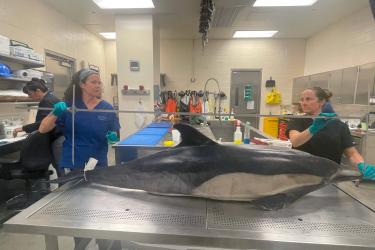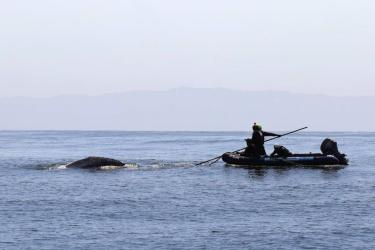Training participant practicing a grapple throw that would be used to attach into any entangling gear trailing behind an animal for satellite tag deployment.
Conditions have been phenomenal in 2015 and 2016 for people to see whales off the West Coast. Humpback, gray, and even blue whales have been observed using nearshore waters in record numbers, making for great whale watching from boats and the shore.

NOAA has continually been working with numerous partners—the fishing industry, state fisheries managers, whale-watch companies, researchers, and conservationists—to minimize or prevent the incidental entanglement of whales. However, more whales visiting coastal waters raises the likelihood of an animal getting entangled in fishing gear or man-made debris, and we’ve seen an uptick in entanglement reports.
NOAA joined with local stranding and entanglement response network volunteers to help match our response capabilities to the immediate need of increased entanglement cases. We conducted numerous training sessions ranging from the San Juan Islands in Washington to San Diego in California to improve the skills and capacity of our authorized disentanglement responders. Thirteen trainings with more than 300 participants, in the classroom and on the water, covered the complexities and dangers of disentanglement response, including the safety measures and authorizations NOAA has in place for those responding to reports of entangled whales.

Responding to whales entangled in fishing gear can be very dangerous, both to the whale and to the trained responders. Human safety is always our first priority. Responders need to be able to assess, document, and potentially remove the life-threatening entangling gear, while ensuring their safety and no additional harm to the whale. Trained personnel and available resources are often the limiting factor when determining if a response is possible. And although increasing trained and authorized response teams is helpful, they won’t be able to free every entangled whale. The ultimate solution is to gain information, through documentation and assessment of recovered entangling material, to guide gear modifications and management strategies to reduce the overall threat for many more animals in the future.
You can help, too. Sighting and documenting issues are the priority for now, and it’s something where everyone can help. While you’re out enjoying whale watching, keep an eye out for any whales that appear entangled or seem in distress. If you spot something amiss, call the hotline at: 877-SOS-WHALE or hail the Coast Guard on Bridge to Bridge Ch. 16 to report it. Remember to keep your distance, no less than 100 yards is recommended, while taking photos or videos to help responders.
We thank our valued Marine Mammal Stranding and Entanglement Response Network partners who joined us for this training.


